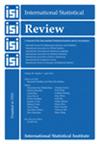Validating an Index of Selection Bias for Proportions in Non‐Probability Samples
IF 1.8
3区 数学
Q1 STATISTICS & PROBABILITY
引用次数: 0
Abstract
SummaryFast online surveys without sampling frames are becoming increasingly important in survey research. Their recruitment methods result in non‐probability samples. As the mechanism of data generation is always unknown in such samples, the problem of non‐ignorability arises making vgeneralisation of calculated statistics to the population of interest highly questionable. Sensitivity analyses provide a valuable tool to deal with non‐ignorability. They capture the impact of different sample selection mechanisms on target statistics. In 2019, Andridge and colleagues proposed an index to quantify potential (non‐ignorable) selection bias in proportions that combines the effects of different selection mechanisms. In this paper, we validate this index with an artificial non‐probability sample generated from a large empirical data set and additionally applied it to proportions estimated from data on current political attitudes arising from a real non‐probability sample selected via River sampling. We find a number of conditions that must be met for the index to perform meaningfully. When these requirements are fulfilled, the index shows an overall good performance in both of our applications in detecting and correcting present selection bias in estimated proportions. Thus, it provides a powerful measure for evaluating the robustness of results obtained from non‐probability samples.验证非概率样本中比例的选择偏差指数
摘要没有抽样框架的快速在线调查在调查研究中变得越来越重要。其招募方法会产生非概率样本。由于这类样本的数据生成机制总是未知的,因此出现了非可视性问题,这使得将计算出的统计数据归纳到相关人群中非常值得怀疑。敏感性分析为解决非可视性问题提供了一个宝贵的工具。它们可以捕捉不同样本选择机制对目标统计数据的影响。2019 年,Andridge 及其同事提出了一种指数,用于量化比例中潜在的(不可忽略的)选择偏差,该指数综合了不同选择机制的影响。在本文中,我们用一个从大型实证数据集生成的人工非概率样本验证了这一指数,并将其应用于从通过河流抽样选出的真实非概率样本所产生的当前政治态度数据中估算出的比例。我们发现,该指数必须满足一些条件才能发挥有意义的作用。在满足这些条件的情况下,该指数在检测和纠正估计比例中存在的选择偏差方面,在我们的两个应用中都表现出了良好的整体性能。因此,它为评估从非概率样本中获得的结果的稳健性提供了一个有力的衡量标准。
本文章由计算机程序翻译,如有差异,请以英文原文为准。
求助全文
约1分钟内获得全文
求助全文
来源期刊

International Statistical Review
数学-统计学与概率论
CiteScore
4.30
自引率
5.00%
发文量
52
审稿时长
>12 weeks
期刊介绍:
International Statistical Review is the flagship journal of the International Statistical Institute (ISI) and of its family of Associations. It publishes papers of broad and general interest in statistics and probability. The term Review is to be interpreted broadly. The types of papers that are suitable for publication include (but are not limited to) the following: reviews/surveys of significant developments in theory, methodology, statistical computing and graphics, statistical education, and application areas; tutorials on important topics; expository papers on emerging areas of research or application; papers describing new developments and/or challenges in relevant areas; papers addressing foundational issues; papers on the history of statistics and probability; white papers on topics of importance to the profession or society; and historical assessment of seminal papers in the field and their impact.
 求助内容:
求助内容: 应助结果提醒方式:
应助结果提醒方式:


